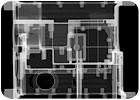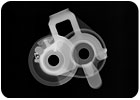
Computed radiography-substituting a phosphor plate for
the sheet of film-is potentially applicable in the same cases as film, but
offers quicker results without chemical processing. Source:
Carestream Health-NDT Solutions Group
For more than a hundred years, industrial manufacturers have been using film-based radiographic techniques (RT) for a full range of inspection needs, from aircraft testing to weld qualification. But in today’s digital world, radiographers are seeking more efficient methods of accomplishing the inspection cycle by using computed and digital technologies for nondestructive testing.
Nondestructive testing (NDT) is ultimately concerned, in a practical sense, with a structure’s performance-is there something wrong with the material or component? How long can it be used and when does it need to be checked again?
Radiography is a method of NDT that involves the use of X-rays or gamma rays to examine parts or products for imperfections without damaging them, ensuring their future usefulness and serviceability.
Radiographic inspection is popular for industrial applications, and often is used to examine variations in structures, track minute changes in surface finish, determine the thicknesses of materials, and detect cracks or other physical defects or characteristics in products.

Technique Selection
There are four primary radiographic technologies: film, computed radiography (CR), digital detector array (DDA) radiography and fluoroscopy. Their application depends primarily on the type and manufacture of a component being tested, its size and engineering requirements. Choosing a system is a matter of weighing the advantages and drawbacks of each technology and how well they meet specific application needs.
Several radiographs done with computed radiography are
shown here, including a plastic gas pipe (top), aluminum castings (bottom) and
aluminum radio housings (topmost image).
Source: Carestream Health-NDT Solutions Group.
Fluoroscopy does allow real-time, continuous observation of an object and, again, eliminates the start-stop delays of shooting film images, mosaic-style, of very large objects. Fluoroscopy therefore remains a cost-efficient technique for large structures, but it lacks the sensitivity to uncover extremely fine detail in some denser materials.
Computed radiography-substituting a phosphor plate for the sheet of film-is potentially applicable in the same cases as film, but offers quicker results without chemical processing. Images on the phosphor plates are read by a device and stored digitally for review and archiving later. Because phosphor plates are typically more sensitive and have greater dynamic range than film, CR also reduces the amount of exposure time needed to generate an image.
DDA radiography, also known as direct radiography (DR), is a filmless, plateless alternative to analog X-ray imaging, employing digital electronic flat panels. Compared to film radiography, DDA radiography is similar to CR in that it offers imaging without wet-film processing, but with shorter exposure times and a wide dynamic range. While DDA is not as mobile as film or CR, the instant access to images is an attractive feature in some applications.
Cost Advantage vs. Cost Trade-off
Comparing the cost of radiographic systems for NDT is a matter of apples and oranges-and bananas, and sometimes the banana tree itself. Equipment cost and useful life varies substantially for the various options, as do costs for consumable goods.Analogue film users must keep buying consumables-film and chemicals. They also maintain film processors, which generally take up more floor space and require more elaborate facilities. Film use also brings environmental and regulatory issues related to effluent discharge, along with inspections and the risk of monetary fines.
The transition to digital requires an initial investment for a computed radiography reader, which will likely cost more than a film processor. On the other hand, processors do not last as long as readers, and they require periodic replacement. Going to CR does not always eliminate the need for film images, which are often digitized after processing.
The greatest cost savings potential by far is in the elimination of film and chemicals when a lab goes completely digital. Again, buyers face a trade-off: a single CR imaging plate can cost a hundred times more than a sheet of film. The good news is that the storage phosphor plate can be erased after each use.
If, modestly speaking, a CR imaging plate lasts for 1,000 cycles, that makes the cost of a CR shot approximately one-tenth the cost of a film shotor even less, considering the cost of chemicals for film processing.
Price
The price of DR systems with flat-panel detectors has come down in recent years-ranging between $80,000 and $150,000-so DR is becoming increasingly popular and may progressively replace computed radiography. Eventual replacement of the selenium or silicon detector panels (DDAs) will cost around $60,000 each.
In comparison, a computed radiography system typically ranges between $75,000 and $125,000. Eventual replacement of a CR reader will cost between $40,000 and $50,000, while imaging plates cost several hundred dollars each. CR plates are capable of thousands of exposures if handled properly. Therefore, cost differences between CR and DR systems are marginal, and of course, depend on brand and model type.
When comparing film and CR applications, it helps to know that for medium-sized operations, CR systems will take about 18 to 24 months to pay off. High-volume operations will see payoff in even less time than that, depending on the cost-per-shot savings of CR vs. film.
CR scanners cost more than film processors; however, the latter must be replaced periodically, whereas CR scanners last many years. The same applies when buying phosphor plates-a single imaging plate can cost a hundred times more than a sheet of film. But, because CR plates can be erased after each use, they end up paying for themselves many times over. So from a cost savings perspective, going digital can be a smart and worthwhile investment.